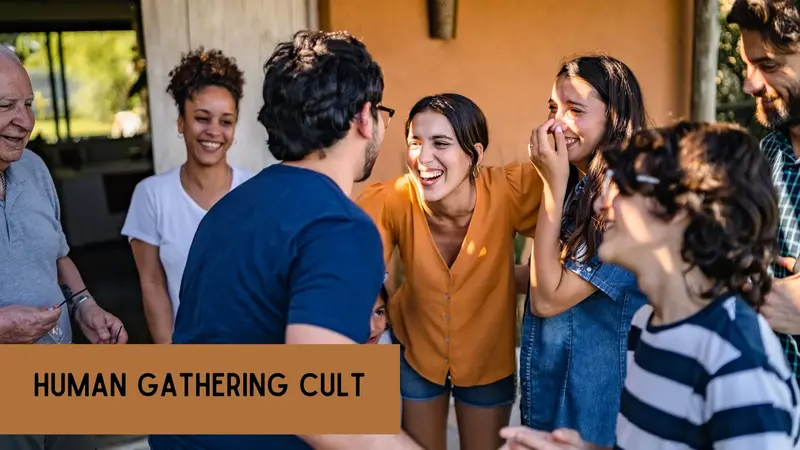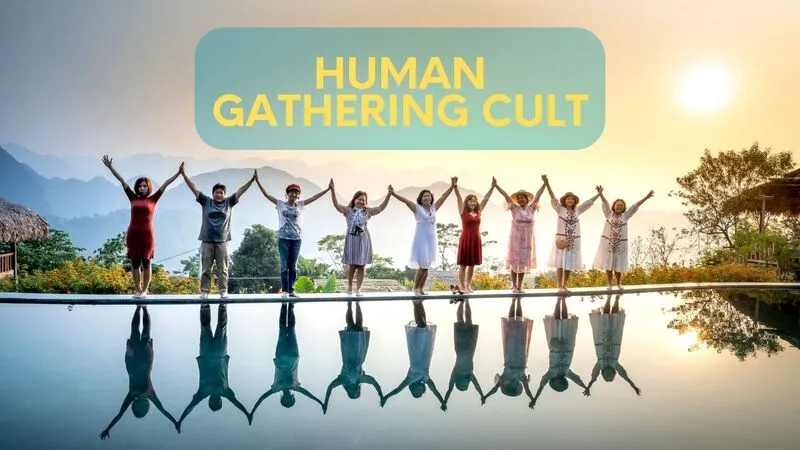Human gathering cults have fascinated and terrified societies throughout history. These enigmatic groups, often shrouded in secrecy, have left an indelible mark on cultural, social, and religious landscapes. This article delves into the world of human gathering cults, exploring their origins, characteristics, influence, and impact on society.
Origins of Human Gathering Cults
Ancient Roots
The concept of human gathering cults is not a modern phenomenon. Ancient civilizations often had secretive groups that performed rituals and ceremonies away from the public eye. These early cults were typically religious, worshiping deities or spirits believed to influence their lives.
- Mystery Religions: In ancient Greece and Rome, mystery religions such as the Eleusinian Mysteries and the Cult of Mithras were prominent. These groups promised esoteric knowledge and a better afterlife to initiates who underwent secret rituals.
- Egyptian Cults: In Egypt, the worship of Osiris and Isis involved secretive ceremonies and gatherings that were believed to grant protection and eternal life.
Medieval and Renaissance Eras
During the medieval and Renaissance periods, secret societies and cults continued to thrive, often intertwined with political and religious power struggles.
- Knights Templar: Originally a Christian military order, the Knights Templar became the subject of numerous conspiracy theories and legends, many portraying them as a secretive cult with hidden knowledge and vast treasures.
- Rosicrucians: Emerging in the early 17th century, the Rosicrucians claimed to possess esoteric wisdom and sought to reform society through mystical and scientific advancements.
Characteristics of Human Gathering Cults
Secrecy and Exclusivity
Human gathering cults are characterized by their secretive nature. Membership is often exclusive, with initiates undergoing rigorous vetting processes. This secrecy serves to create a sense of mystique and loyalty among members.
- Initiation Rites: Many cults have elaborate initiation rites that new members must undergo. These rites often involve symbolic acts, oaths of secrecy, and sometimes, psychological or physical challenges.
- Hierarchical Structure: Cults typically have a hierarchical structure, with a charismatic leader at the top. This leader is often seen as possessing unique insights or divine guidance.
Rituals and Ceremonies
Rituals and ceremonies are central to the functioning of human gathering cults. These practices can range from the benign to the bizarre, and sometimes, to the dangerous.
- Symbolic Rituals: Many cults use symbols and rituals to create a sense of belonging and to reinforce the group’s beliefs. These can include chants, dances, and symbolic sacrifices.
- Isolation from Society: Cults often encourage or enforce isolation from mainstream society. This helps to control the narrative and maintain the influence of the cult leaders over the members.
Influence of Human Gathering Cults
Cultural and Religious Impact
Throughout history, human-gathering cults have influenced mainstream cultures and religions, often leaving a lasting legacy.
- Syncretism: Many mainstream religions have absorbed elements from cult practices. For example, early Christianity incorporated rituals and symbols from various mystery religions.
- Art and Literature: The mystique of cults has inspired countless works of art and literature. From ancient mythology to modern films, the allure of secret societies continues to captivate the imagination.
Social and Political Ramifications
Cults can have significant social and political implications, sometimes leading to conflict and controversy.
- Social Disruption: Some cults have caused social upheaval by challenging established norms and authorities. This can lead to tension, conflict, and in extreme cases, violence.
- Political Manipulation: In certain instances, cults have been used as tools for political manipulation. Leaders may use the cult’s influence to push political agendas or to control populations.
Modern Human Gathering Cults
Contemporary Examples
In the modern era, human gathering cults have taken on new forms, often influenced by contemporary social and technological developments.
- New Religious Movements: Many modern cults present themselves as new religious movements, offering alternative spiritual paths in a rapidly changing world. Examples include the Church of Scientology and the Raelian Movement.
- Conspiracy Theories: Some modern cults are centered around conspiracy theories, blending political, social, and religious elements. These groups often use the internet to spread their beliefs and to recruit new members.
Psychological and Sociological Perspectives
Understanding why people join and stay in cults requires exploring psychological and sociological factors.
- Psychological Manipulation: Cults often employ psychological manipulation techniques, such as brainwashing and coercive persuasion, to maintain control over their members.
- Social Influence: Sociological factors, such as the need for belonging and identity, play a crucial role in the appeal of cults. They often provide a sense of community and purpose that individuals may not find elsewhere.
The Impact of Human Gathering Cults on Society
Positive Contributions
While the term “cult” often carries negative connotations, not all human gathering cults have a detrimental impact. Some contribute positively to society by providing support, community, and alternative viewpoints.
- Community and Support: For some members, cults offer a supportive community that helps them through difficult times. This sense of belonging can have a positive impact on their mental and emotional well-being.
- Alternative Perspectives: Some cults challenge mainstream views, offering alternative perspectives that can stimulate critical thinking and societal change.
Negative Consequences
However, the darker side of human gathering cults cannot be ignored. The potential for abuse, manipulation, and harm is significant.
- Abuse and Exploitation: Many cults have been exposed for abusing and exploiting their members, both psychologically and physically. Leaders may use their power to manipulate members for personal gain.
- Social Isolation: The isolation from mainstream society can have severe consequences, including estrangement from family and friends, and difficulties reintegrating into society if members leave the cult.
Cult Dynamics: Case Studies
The Peoples Temple
One of the most infamous modern examples of a human gathering cult is the Peoples Temple, led by Jim Jones. This group, which began as a seemingly benevolent religious organization, ultimately ended in tragedy.
- Charismatic Leadership: Jim Jones was a charismatic leader who promised equality and social justice, attracting a diverse following.
- Isolation and Control: Jones moved his followers to Jonestown, Guyana, where he exerted extreme control over their lives.
- Tragic End: In 1978, over 900 members of the Peoples Temple died in a mass murder-suicide, highlighting the potential for destructive power in cults.
Heaven’s Gate
Heaven’s Gate is another notable example, demonstrating the influence of cults in the digital age.
- Tech-Savvy Recruitment: Heaven’s Gate used the internet to spread its message and recruit new members, a pioneering move at the time.
- Apocalyptic Beliefs: The cult believed that a spaceship trailing the Hale-Bopp comet would take them to a higher plane of existence.
- Mass Suicide: In 1997, 39 members of Heaven’s Gate committed suicide in a coordinated event, believing they were ascending to the spaceship.
Psychological and Sociological Insights
The Appeal of Cults
Understanding why people join cults involves examining a variety of psychological and sociological factors.
- Sense of Belonging: Many individuals are drawn to cults due to a desire for belonging and community, which the cult promises to provide.
- Identity and Purpose: Cults often offer a clear sense of identity and purpose, which can be particularly appealing to those feeling lost or disillusioned.
- Charismatic Leaders: The influence of charismatic leaders cannot be understated. Their persuasive power can inspire unwavering loyalty and devotion.
The Process of Indoctrination
Cults employ a variety of techniques to indoctrinate and control their members.
- Isolation: By isolating members from their previous lives and support networks, cults increase dependence on the group.
-
Many cults use deceptive practices to recruit new members, often hiding their true intentions until the individual is fully integrated. They commonly use techniques such as love bombing, fear tactics, and guilt to manipulate and control members
The Role of Media and Public Perception
Sensationalism and Stigma
The media often sensationalizes cults, which can impact public perception and understanding.
- Media Coverage: High-profile cases of cults often receive extensive media coverage, focusing on the most sensational and shocking aspects.
- Stigmatization: This can lead to the stigmatization of all unconventional religious or social groups, regardless of their actual practices or intentions.
Education and Awareness
Promoting education and awareness about cult dynamics is essential for preventing harm and supporting those affected.
- Public Education: Increasing public understanding of how cults operate can help individuals recognize warning signs and make informed decisions.
- Support Networks: Providing support for former cult members is crucial for their reintegration into society and recovery from psychological trauma.
Conclusion
Human gathering cults are complex phenomena that have evolved over millennia. From ancient mystery religions to modern new religious movements, these groups continue to captivate, influence and sometimes terrify societies. Understanding the origins, characteristics, and impact of human gathering cults is crucial for recognizing their role in shaping human history and culture. As we move forward, it is essential to approach this subject with both curiosity and caution, acknowledging the potential for both positive and negative outcomes. Through continued study and awareness, we can better understand these enigmatic groups and their place in our world. If you have any questions, please visit the Kaz World Mag.


